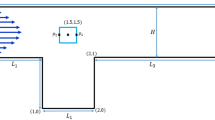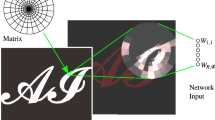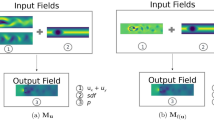Abstract
A lot of computational resources are required for time-dependent CFD simulations for the accurate prediction of the quantities of interest. To circumvent such difficulties, an artificial neural network (ANN) has been coupled with CFD simulations. Training and validation datasets have been generated by CFD and then are fed through ANN with optimal number of neurons and inner layers. A well-known benchmark problem for incompressible flows, namely, the flow around cylinder has been considered for the hybrid CFD network. The mathematical formulations are based on nonstationary Navier–Stokes equations incorporating the viscosity through power-law fluid constitutive model. The underlying ANN model consists of 3 input layers, 2 output layers, and 10 hidden layers. The network has been trained through one of the most efficient backpropagation algorithms, namely, Levenberg–Marquardt (LM) algorithm that provides second-order training speed. The obtained finite element results for drag and lift coefficients have been validated with the ANN predicted values through statistical measures represented by mean square error (MSE) and the coefficient of determination (R). For all cases, we have obtained a higher predictivity for drag coefficient \(C_{D}\) and lift coefficient \(C_{L}\) as MSE values approached zero and R values found to be close to unity. The agreement between the CFD results and the data predicted from ANN determined via the correlations is within less than ± 5% errors. It is concluded that ANNs may help to reduce the computing time and other resources required for time-dependent simulations.






Similar content being viewed by others
Data Availability Statement
The authors declare that the data supporting the findings of this study are available within the paper.
References
F. Regazzoni, L. Ded’e, A. Quarteroni, Machine learning for fast and reliable solution of time-dependent differential equations. J. Comput. Phys. 397, 108852 (2019)
Y. Shin, On the convergence of physics informed neural networks for linear second-order elliptic and parabolic type PDEs. Commun. Comput. Phys. 28(5), 2042–2074 (2020)
M. Guo, J.S. Hesthaven, Data-driven reduced order modeling for time-dependent problems. Comput. Methods Appl. Mech. Eng. 345, 75–99 (2019)
G. Pitton, G. Rozza, On the application of reduced basis methods to bifurcation problems in incompressible fluid dynamics. J. Sci. Comput. 73(1), 157–177 (2017)
M. Raissi, P. Perdikaris, G.E. Karniadakis, Physics-informed neural networks: a deep learning framework for solving forward and inverse problems involving nonlinear partial differential equations. J. Comput. Phys 378, 686–707 (2019)
F. Selimefendigil, H.F. Oztop, Fuzzy-based estimation of mixed convection heat transfer in a square cavity in the presence of an adiabatic inclined fin. Int. Commun. Heat Mass Transfer 39, 1639–1646 (2012)
S.O. Atayılmaz, H. Demir, O. Agra, Application of artificial neural networks for prediction of natural convection from a heated horizontal cylinder. Int. Commun. Heat Mass Transfer 37, 68–73 (2010)
E. Gunpinar, U.C. Coskun, M. Ozsipahi, S. Gunpinar, A generative design and drag coefficient prediction system for sedan car side silhouettes based on computational fluid dynamics. Comput. Aided Des. 111, 65–79 (2019)
S. Hussain, F. Schieweck, S. Turek, An efficient and stable finite element solver of higher order in space and time for nonstationary incompressible flow. Int. J. Numer. Meth. Fluids 73(11), 927–952 (2013)
R.P. Chhabra, A.A. Soares, J.M. Ferreira, Steady non–Newtonian flow past a circular cylinder: a numerical study. Acta Mech. 172(1–2), 1–16 (2004)
C.H.K. Williamson, Vortex dynamics in the cylinder wake. Annu. Rev. Fluid Mech. 28(1), 477–539 (1996)
P. Sivakumar, R.P. Bharti, R.P. Chhabra, Effect of power-law index on critical parameters for power-law flow across an unconfined circular cylinder. Chem. Eng. Sci. 61(18), 6035–6046 (2006)
D.J. Tritton, Experiments on the flow past a circular cylinder at low Reynolds numbers. J. Fluid Mech. 6(4), 547–567 (1959)
M.J. Whitney, J.R. Gregory, Force velocity relationships for rigid bodies translating through unbounded shear-thinning power-law fluids. Int. J. Non-Linear Mech. 36(6), 947–953 (2001)
O.A. Abegunrin, I.L. Animasaun, N. Sandeep, Insight into the boundary layer flow of nonNewtonian Eyring-Powell fluid due to catalytic surface reaction on an upper horizontal surface of a paraboloid of revolution. Alex. Eng. J. 57(3), 2051–2060 (2018)
V.K. Patnana, R.P. Bharti, R.P. Chhabra, Two-dimensional unsteady flow of power-law fluids over a cylinder. Chem. Eng. Sci. 64, 2978–2999 (2009)
F. Pichi, F. Ballarin, G. Rozza, J.S. Hesthaven, An artificial neural network approach to bifurcating phenomena in computational fluid dynamics. Computer & Fluids 254, 105813 (2023)
S. Hijazi, G. Stabile, A. Mola, G. Rozza, Data-driven POD-Galerkin reduced order model for turbulent flows. J. Comput. Phys. 416, 109513 (2020)
A. Gholami, H. Bonakdari, A.A. Akhtari, I. Ebtehaj, A combination of computational fluid dynamics, artificial neural network, and support vector machines models to predict flow variables in curved channel. Scientia Iranica 26(2), 726–741 (2019)
D. Kochkov, J.A. Smith, A. Alieva, S. Hoyer, Machine learning-accelerated computational fluid dynamics. Appl. Math. 118, e2101784118 (2021)
R. Mahmood, S. Bilal, A.H. Majeed, I. Khan, E.S.M. Sherif, A comparative analysis of flow features of Newtonian and power law material: a new configuration. J. Mater. Res. Technol. 9(2), 1978–1987 (2020)
A.H. Majeed, R. Mahmood, W.S. Abbasi, K. Usman, Numerical computation of MHD thermal flow of cross model over an elliptic cylinder: reduction of forces via thickness ratio. Math. Probl. Eng. 2021, 1–13 (2021)
R. Mahmood, S. Bilal, A.H. Majeed, I. Khan, K.S. Nisar, Assessment of pseudo-plastic and dilatant materials flow in channel driven cavity: application of metallurgical processes. J. Mater. Res. Technol. 9(3), 3829–3837 (2020)
A.H. Majeed, F. Jarad, R. Mahmood, I. Saddique, Topological characteristics of obstacles and nonlinear rheological fluid flow in presence of insulated fins: a fluid force reduction study. Math. Probl. Eng. 2021, 1–15 (2021)
H. Ahmad, R. Mahmood, M.B. Hafeez, A. Hussain Majeed, S. Askar, H. Shahzad, Thermal visualization of Ostwald-de Waele liquid in wavy trapezoidal cavity: effect of undulation and amplitude. Case Stud. Therm. Eng. 29, 101698 (2021)
O. Schenk, K. Gärtner, PARDISO, in Encyclopedia of parallel computing. ed. by D. Padua (Springer, Boston, 2011)
Author information
Authors and Affiliations
Corresponding author
Rights and permissions
Springer Nature or its licensor (e.g. a society or other partner) holds exclusive rights to this article under a publishing agreement with the author(s) or other rightsholder(s); author self-archiving of the accepted manuscript version of this article is solely governed by the terms of such publishing agreement and applicable law.
About this article
Cite this article
Mahmood, R., Majeed, A.H., Shahzad, H. et al. Novel prediction of fluid forces on obstacle in a periodic flow regime using hybrid FEM-ANN simulations. Eur. Phys. J. Plus 138, 741 (2023). https://doi.org/10.1140/epjp/s13360-023-04225-5
Received:
Accepted:
Published:
DOI: https://doi.org/10.1140/epjp/s13360-023-04225-5




